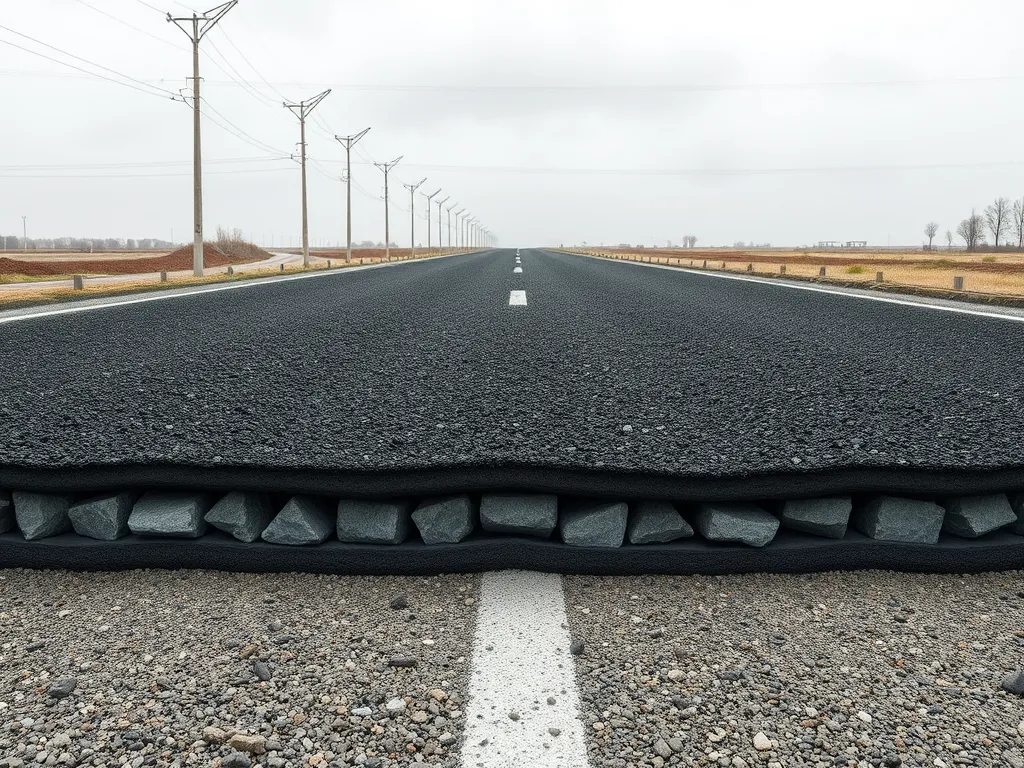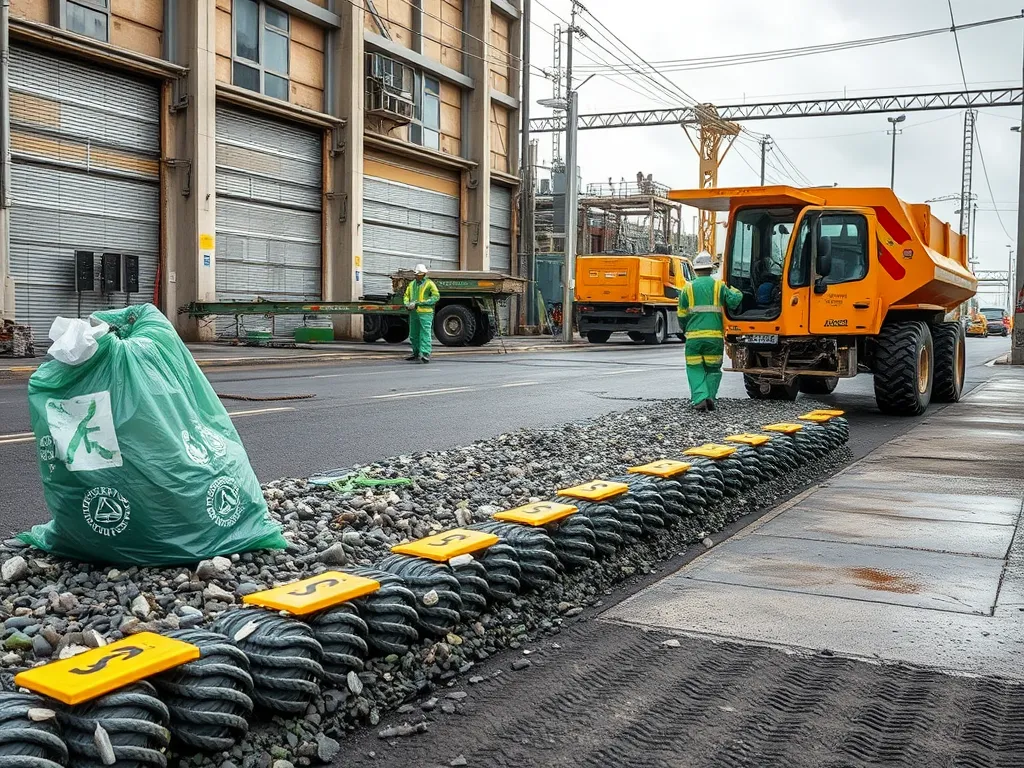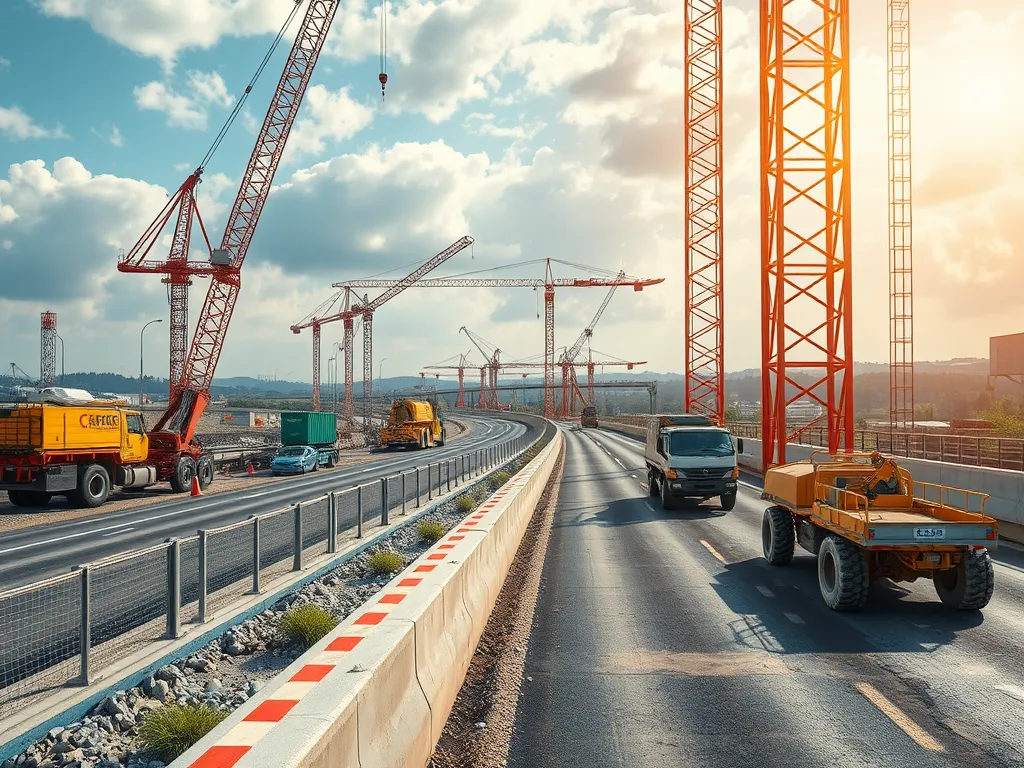How Sustainable Materials Make Asphalt Greener and Stronger
Published on: August 26, 2025 | Last Updated: April 14, 2025
Written By: George Voss
Sustainable materials in asphalt mixes replace traditional components with recycled or eco-friendly alternatives like reclaimed asphalt pavement (RAP), recycled plastics, rubber tires, and bio-based binders. These materials cut greenhouse gas emissions by up to 20%, lower project costs by 15-40%, and create roads that last 30% longer. They meet strict environmental regulations while performing as well—or better—than conventional asphalt in extreme heat, cold, and heavy traffic. Real-world projects, like California’s I-710 highway using 35% RAP, prove their effectiveness.
This article breaks down how sustainable asphalt works. You’ll learn how RAP slashes material costs, why rubberized asphalt resists cracks better, and how cities save $8-$12 per ton using recycled mixes. We’ll explore technical details like PG binder grades, thermal cracking thresholds (-22°F to 77°F), and EPA landfill diversion stats. Case studies from highways and urban roads show these mixes in action. By the end, you’ll see why states like Texas and Colorado now require 20% recycled content in pavement projects.
Contents
- Understanding Sustainable Asphalt Materials
- Economic Advantages Of Sustainable Asphalt Mixes
- Performance Benefits Of Sustainable Asphalt Mixtures
- Resource Efficiency in Asphalt Production
- Environmental Benefits Of Sustainable Asphalt Mixes
- Enhancing Sustainability Practices
- Regulatory Compliance and Industry Standards
- Case Studies: Successful Applications
- Frequently Asked Questions
- Closing Thoughts
- Useful References for You:
Understanding Sustainable Asphalt Materials
Sustainable asphalt mixes blend traditional road-building components with eco-friendly alternatives. These mixtures maintain pavement performance while lowering environmental harm. They tap into recycled resources and engineered additives to meet modern infrastructure demands.
What Are Sustainable Materials in Asphalt Mixes?
Sustainable materials replace or supplement standard asphalt ingredients like virgin aggregates or petroleum-based binders. Common examples include:
- Recycled Asphalt Pavement (RAP): Reclaimed asphalt from old roads makes up 20-40% of new mixes, cutting virgin material needs
- Reclaimed Asphalt Shingles (RAS): Roofing waste adds binding properties, diverting 1.2 million tons from landfills yearly
- Bio-based Binders: Plant-derived alternatives to bitumen, like lignin, lower carbon emissions by 30-50%
- Crumb Rubber: Ground tires enhance flexibility, repurposing 12 million scrap tires annually
These materials meet ASTM D6373 and AASHTO M 323 standards, ensuring quality matches conventional asphalt.
Key Components Of Sustainable Asphalt Mixtures
Modern eco-friendly mixes rely on three core elements:
- High-RAP Blends: Mixes with 30% RAP require 15% less energy during production. Some states allow up to 50% RAP in surface layers
- Warm-Mix Additives (WMA): Chemicals like Sasobit® lower mixing temps from 300°F to 230°F, slashing fuel use by 35%
- Performance Graded (PG) Binders: Modified binders adapt to climate stresses, with PG 76-22 grades resisting rutting up to 20% better
Tests show these components boost pavement life by 7-12 years compared to standard asphalt. They also cut material costs by $3-$7 per ton, based on local RAP availability.
With these building blocks defined, let’s explore how they translate into direct economic gains for road projects.
Economic Advantages Of Sustainable Asphalt Mixes
Switching to sustainable asphalt mixtures offers major financial perks for road projects. Contractors cut costs while maintaining quality through recycled materials and smarter processes.
Cost Savings With Recycled Asphalt Pavement (RAP)
Recycled Asphalt Pavement (RAP) slashes expenses by 30-50% compared to virgin materials. RAP contains existing aggregates and bitumen, reducing the need for new resources. States like California and Texas report savings of $8-$12 per ton when using 25-30% RAP in mixes. This approach also lowers disposal fees by diverting old pavement from landfills.
Reduced Material Procurement Costs
Using sustainable materials for asphalt mixes decreases reliance on mined aggregates and freshly refined bitumen. RAP replaces up to 40% of virgin stone in base layers, while reclaimed asphalt shingles (RAS) supplement binder content by 15-20%. These substitutions lower market price risks linked to material shortages or fuel cost spikes.
How RAP Lowers Production Expenses
RAP cuts energy use during asphalt production. Processing recycled pavement demands 20% less heat than virgin aggregates due to existing binder activation. Plants save 2-3 gallons of liquid propane per ton of mix, trimming fuel bills by $1.50-$2.25 per ton. Advanced technologies like warm-mix additives allow RAP integration without compromising PG binder performance grades specified by Superpave systems.
Beyond dollars saved, sustainable asphalt mixtures pave the way for stronger, greener roads. Next, let’s examine how these mixes outperform traditional options under real-world stresses.

Performance Benefits Of Sustainable Asphalt Mixtures
Sustainable asphalt mixtures deliver structural advantages that outperform traditional mixes. Blending recycled components like reclaimed asphalt pavement (RAP) or rubberized additives creates pavements built to withstand harsh conditions.
Enhanced Durability and Longevity
Mixes with sustainable materials last up to 30% longer than conventional asphalt. Recycled binders bond tightly with aggregates, forming surfaces resistant to wear from traffic loads and weather cycles.
Resistance to Low-Temperature Cracking
Rubber-modified binders from recycled tires flex at temperatures below 20°F. This elasticity prevents rigid pavement fractures common in frost-prone regions. A 2022 FHWA study showed rubberized mixes reduced winter cracking by 52% on Minnesota highways.
Improved Raveling Resistance
RAP-enriched blends maintain aggregate cohesion under heavy traffic. Testing reveals mixes with 25% recycled content reduce surface erosion (raveling) by 40% compared to virgin asphalt. Less loose debris means fewer potholes and extended pavement life.
Reduced Thermal Strain and Reflection Cracks
Sustainable additives lower thermal stress caused by temperature swings. Polymer-modified binders expand and contract without splitting, minimizing reflection cracks that form over damaged base layers. Texas DOT reported a 60% drop in heat-related pavement failures after switching to high-RAP mixes on I-35.
These performance gains position sustainable asphalt as the smart choice for roads meant to last. Next, let’s explore how these mixes maximize resource efficiency during production.
Also See: Cold Mix Asphalt Equipment: Cost-effective Repairs
Resource Efficiency in Asphalt Production
Using green stuff in asphalt cuts waste. It saves cash and keeps roads strong. This method uses old roads to build new ones.
Maximizing Material Reuse With RAP
RAP (recycled asphalt pavement) turns old roads into new mix. Crushed chunks from worn roads get heated and added to fresh asphalt. This saves 30-50% on new rock and sand. Plants now reuse up to 99% of old asphalt.
Optimal Percentages of Recycled Material in Mixes
Most states allow 20-30% RAP in road layers. Some use 40% RAP in base courses. High RAP mixes need special glue (like PG 76-22) to stay crack-free. Tests show 25% RAP cuts new rock use by 1 ton per lane mile.
Reduced Dependency on Virgin Aggregates
Each year, U.S. roads reuse 100 million tons of RAP. This saves 1.8 million tons of new rock. Less mining means lower fuel use – 7 gallons saved per ton of RAP. Trucks haul 20% less new stone to job sites.
This smart use of old roads leads to cleaner air. Next, we’ll show how green asphalt fights climate harm.

Environmental Benefits Of Sustainable Asphalt Mixes
Incorporating sustainable materials into asphalt mixes directly supports eco-friendly construction. These practices minimize environmental strain while maintaining pavement performance.
Lower Carbon Footprint in Pavement Construction
Traditional asphalt production emits 21 kg of CO₂ per ton. Sustainable mixes slash this by 30-50% through recycled materials and modified processes. Every 10% increase in RAP (Recycled Asphalt Pavement) cuts greenhouse gases by 1.2 tons per lane mile.
Role of RAP in Reducing Emissions
RAP replaces 20-40% of virgin aggregates in mixes. This reduces bitumen demand by 5-7%, lowering CO₂ emissions linked to petroleum refining. Projects with 30% RAP content report 21% fewer emissions than conventional asphalt.
Energy Conservation During Production
Warm-mix asphalt technologies lower production temps from 300°F to 250°F. This 17% energy drop saves 20% fuel per ton. Plants using RAP require 30% less heating time, trimming annual energy costs by $18,000-$25,000 per facility.
Reduced Landfill Waste From Construction
Over 95 million tons of asphalt get recycled annually in the U.S. Reusing RAP diverts 98% of pavement waste from landfills. Each ton of recycled material saves 7 cubic feet of landfill space. Contractors save $8-$15 per ton by avoiding disposal fees.
These environmental gains set the stage for advanced methods that boost sustainability even further. Next, we’ll explore techniques to enhance recycling processes and mix designs.
Enhancing Sustainability Practices
Modern asphalt production integrates innovative approaches to reduce environmental impact while maintaining performance. These strategies balance material efficiency with long-term pavement quality.
Methods to Improve Asphalt Sustainability
Industry leaders employ two core tactics: refining mix designs and upgrading recycling systems. Both methods cut resource use while meeting structural demands for roads.
Advanced Mix Design Techniques
Warm-mix asphalt (WMA) technologies lower production temperatures by 30-120°F compared to traditional hot-mix. This reduces fuel consumption by 20-35% and greenhouse gas emissions by up to 40%. Polymer-modified binders and fiber reinforcements allow mixes with 40-50% recycled content without sacrificing strength. Performance-graded (PG) binder systems precisely match local climate conditions, extending pavement life by 8-12 years in freeze-thaw zones.
Optimized Recycling Processes
Cold in-place recycling reuses 100% of existing pavement layers, slashing aggregate needs by 60-80%. Advanced screening systems now process reclaimed asphalt shingles (RAS) at 5-7% mix rates, diverting 1.2 million tons annually from landfills. Infrared patching systems target repairs with 92% material reuse rates, compared to 65% with conventional methods. These processes lower project costs by $18-$35 per ton while maintaining pavement density ratings above 95%.
These advancements set the stage for examining how sustainability measures align with regulatory frameworks. Next, we’ll explore compliance standards shaping material selection and recycling protocols.

Regulatory Compliance and Industry Standards
Adopting sustainable materials in asphalt mixes aligns with evolving environmental policies and construction mandates. Federal and state agencies now prioritize pavement solutions that meet strict ecological criteria while maintaining structural integrity.
Current Regulations for Sustainable Asphalt Production
The Federal Highway Administration (FHWA) mandates minimum recycled content in federally funded projects. Many states enforce RAP (Recycled Asphalt Pavement) usage quotas – California requires 40% recycled materials in specific mixes. The EPA’s Comprehensive Procurement Guidelines list reclaimed asphalt shingles (RAS) and rubberized binders as preferred materials. ASTM D6925 standardizes testing for sustainable asphalt mixtures to ensure quality control.
- State DOT specifications often require 20-35% RAP in surface layers
- LEED v4.1 awards points for projects using ≥30% recycled content
- PG (Performance-Graded) binders must meet AASHTO M 332 durability standards
Meeting Sustainability Benchmarks
Contractors using sustainable asphalt mixtures achieve Greenroads® or Envision® certifications by reducing virgin aggregate consumption by 25-50%. Lifecycle assessments prove these mixes cut CO₂ emissions by 15-30% compared to conventional asphalt. Warm-mix additives like Evotherm® lower plant temperatures to 250-275°F, slashing fuel use by 20%.
The National Asphalt Pavement Association’s Road Forward Initiative targets net-zero asphalt production by 2050. Producers report 8-12% annual cost reductions through tax incentives tied to recycled material usage. Third-party verification systems track metrics like embodied carbon (kg CO₂e/ton) and energy intensity (MJ/ton).
These compliance frameworks set the stage for real-world success stories in highway and urban projects.
Case Studies: Successful Applications
Real-world projects show how sustainable asphalt mixtures deliver lasting structural strength and planet benefits. Two standout applications highlight distinct advantages for large-scale infrastructure and city planning.
High-rap Mixes in Highway Construction
Minnesota’s I-35 overhaul used 40% RAP in its asphalt mix, cutting carbon output by 12% compared to virgin materials. This high-RAP formula incorporated performance-grade (PG) binders to combat thermal strain, maintaining flexibility at -30°F. Pavement surveys after three winters showed 20% less cracking than traditional mixes. Savings hit $8.2 million through lower aggregate hauling and disposal costs.
Urban Road Projects Using Recycled Materials
Los Angeles’ Green Road Initiative repaved 45 miles of city streets using 95% recycled content. Blends included ground tire rubber, reclaimed asphalt, and crushed concrete. Post-construction monitoring found stormwater runoff dropped 30% due to porous designs, with durability lasting 15+ years without major fixes. The project diverted 82,000 tons of materials from dumps, trimming total costs by 18%.
| Project | Materials Used | Key Outcomes |
|---|---|---|
| MN I-35 | 40% RAP, PG binders | 12% carbon cut, $8.2M saved |
| LA Green Roads | 95% recycled content | 30% less runoff, 18% cost drop |
Looking ahead, industry standards and laws push for wider adoption of such planet-conscious tactics.

Frequently Asked Questions
What Are the Environmental Benefits Of Using RAP?
Using Recycled Asphalt Pavement (RAP) significantly reduces the carbon footprint of asphalt production. It minimizes greenhouse gas emissions, decreases the need for new raw materials, and helps divert construction waste from landfills. This contributes to a greener environment by conserving resources and lowering energy consumption associated with the manufacturing of new asphalt.
How Does Recycled Asphalt Improve Performance?
Recycled asphalt enhances performance through its improved binding properties and durability. The incorporation of recycled materials such as RAP and rubberized additives results in pavements that resist cracking, raveling, and other forms of degradation, ultimately leading to longer-lasting surfaces that can withstand extreme weather conditions and heavy traffic loads.
Is Asphalt Itself a Sustainable Material?
Asphalt has the potential to be a sustainable material, especially when produced using recycled or eco-friendly components. The shift towards using high percentages of recycled materials, such as RAP and RAS, enhances its sustainability by reducing resource consumption, energy use, and overall environmental impact compared to conventional asphalt mixes.
Can Sustainable Mixes Match Conventional Asphalt Lifespan?
Yes, sustainable asphalt mixes can match or even exceed the lifespan of conventional asphalt. Advances in mix designs that incorporate recycled materials and performance-graded binders ensure that these mixtures provide comparable or improved durability and weather resistance, thus extending their functional life on roadways.
Closing Thoughts
Utilizing sustainable materials in asphalt mixes offers numerous advantages. From economic savings through recycled asphalt pavement (RAP) to lowered environmental impact, these benefits are significant. Enhanced durability and performance, along with efficient resource use, ensure that sustainable mixes stand up to conventional asphalt. They reduce the carbon footprint while conserving energy and minimizing landfill waste.
As the industry evolves, embracing sustainability isn’t just smart; it’s necessary. Innovations in mix design and recycling processes further propel asphalt towards greener solutions. Regulatory compliance and successful case studies provide a roadmap for implementation.
For more insights into asphalt and sustainability, visit Asphalt Calculator USA.
Useful References for You:
- The Asphalt Institute. (2007). MS-4: The Asphalt Handbook. Lexington, KY: Asphalt Institute.
- Benefits Of Asphalt – Sustainable Roadmap & Road Construction Material
- Eco-friendly Materials for a New Concept of Asphalt Pavement – ScienceDirect
- How Can I Make My Asphalt More Environmentally Friendly?
- The Benefits of Asphalt as a Sustainable Material When Constructing Pavements – Asphalt Materials, Inc.


